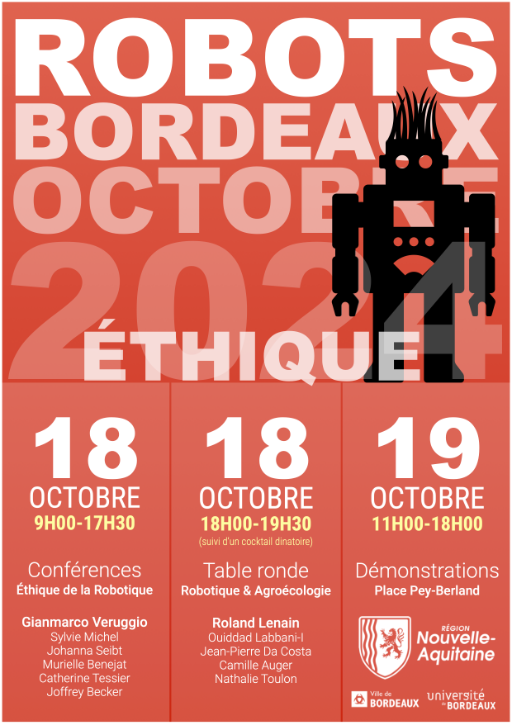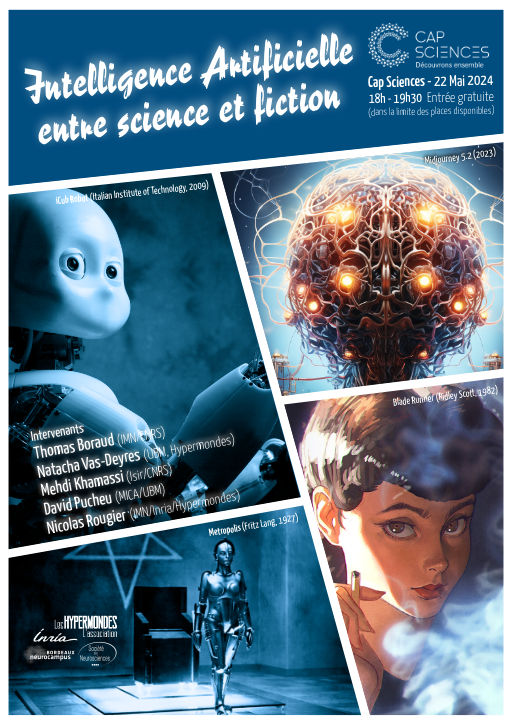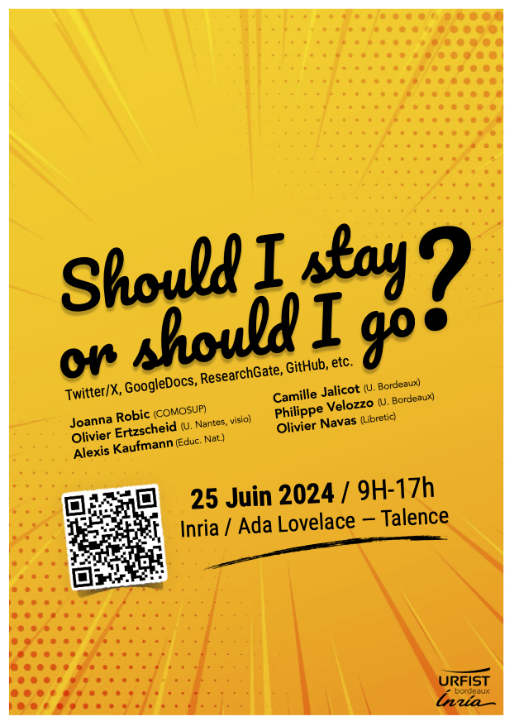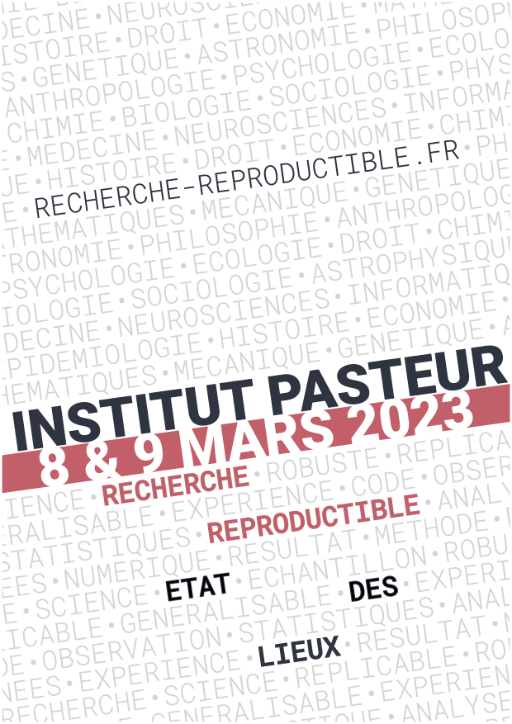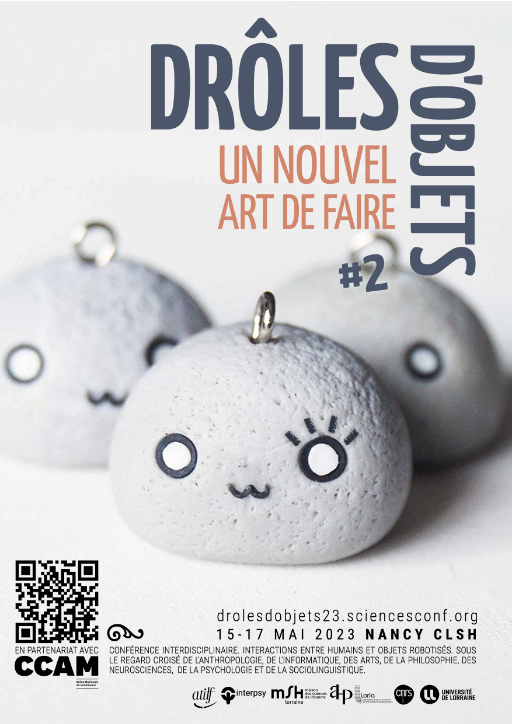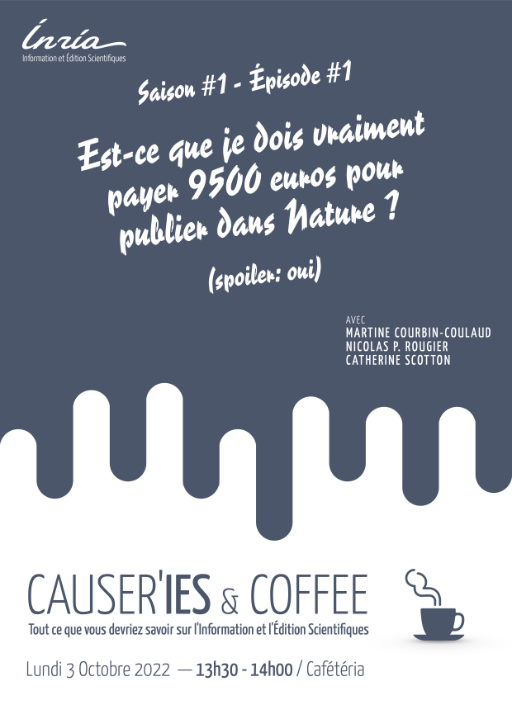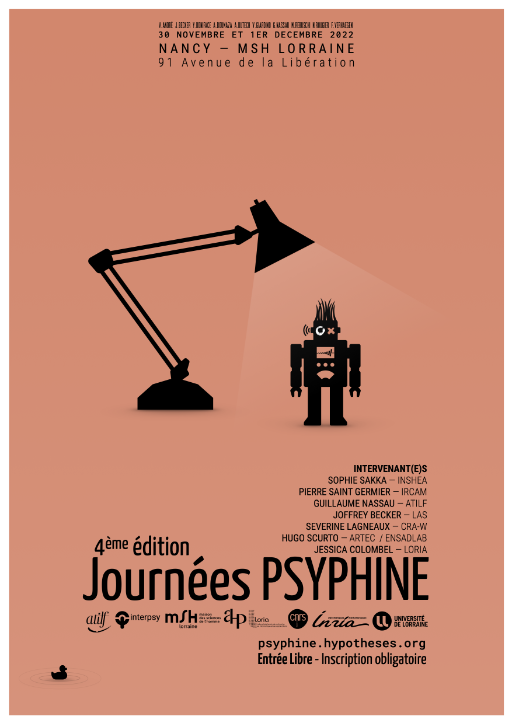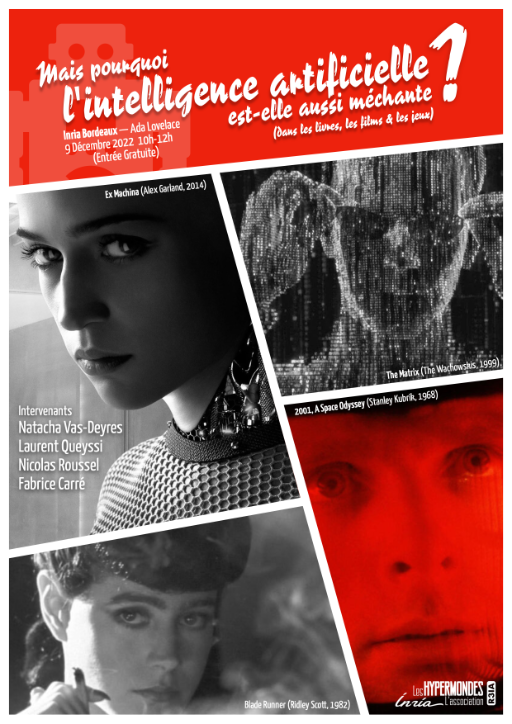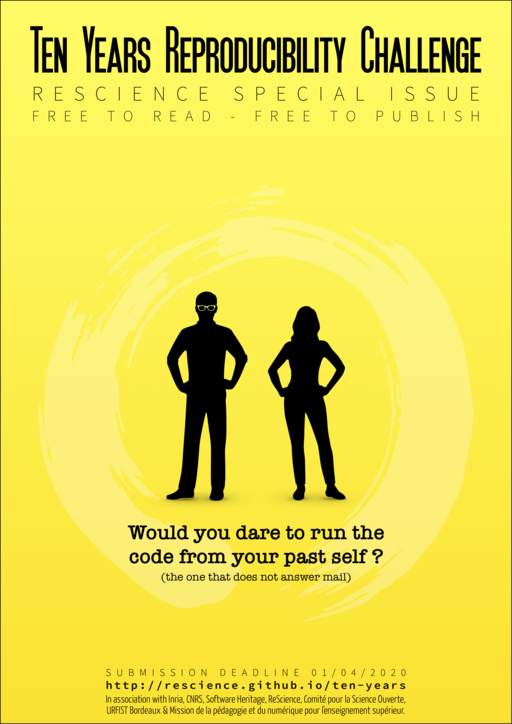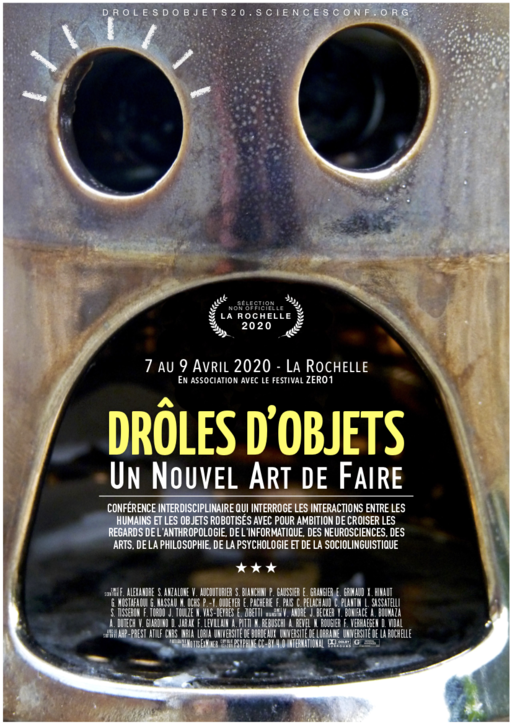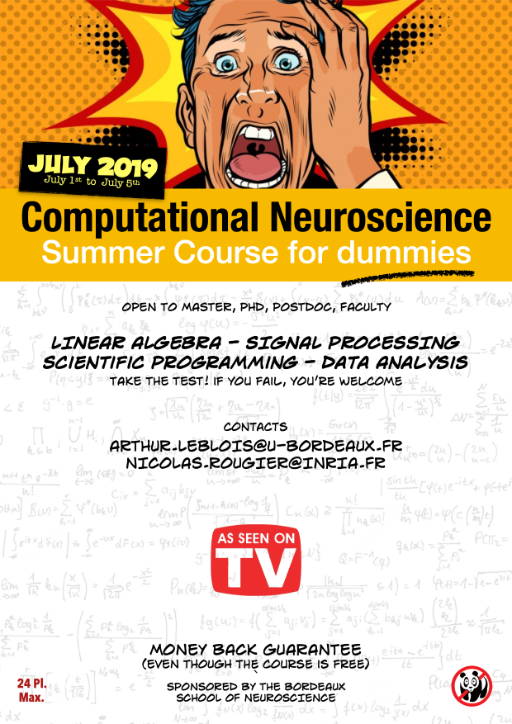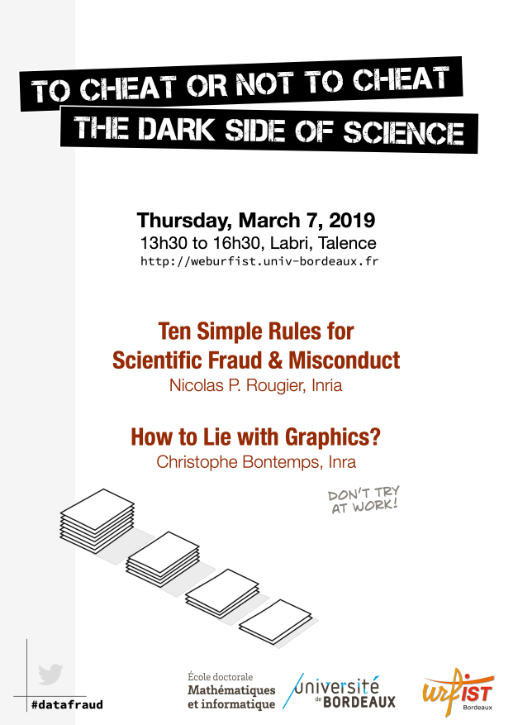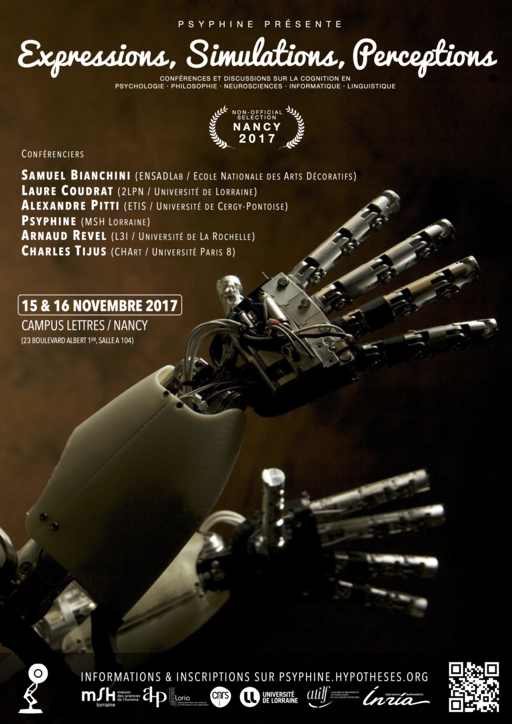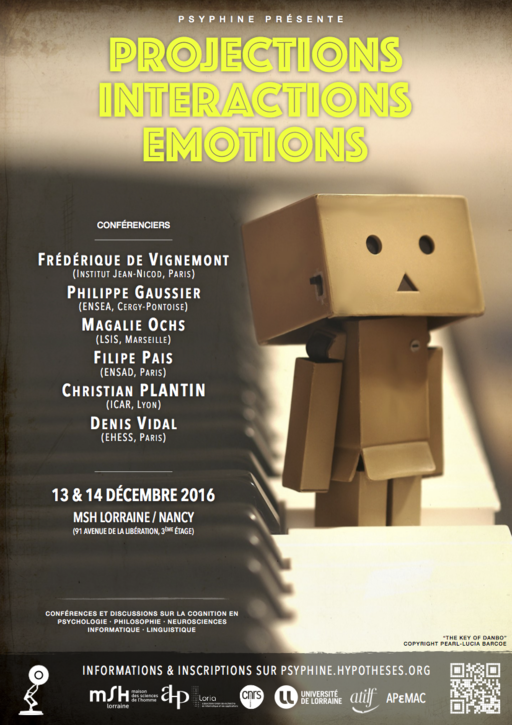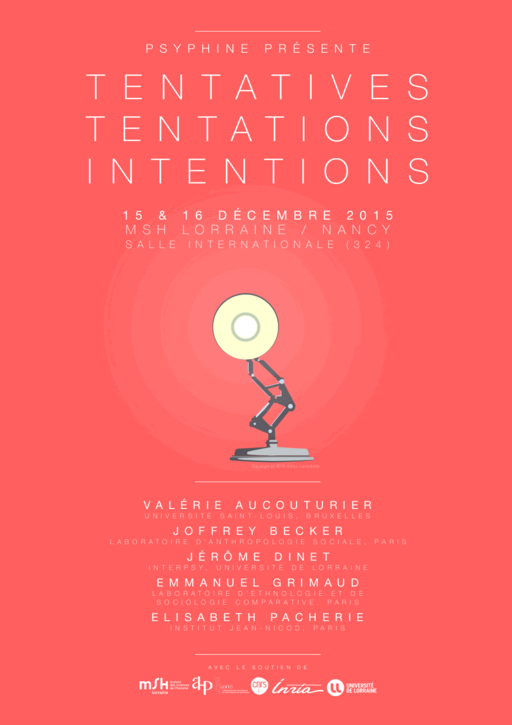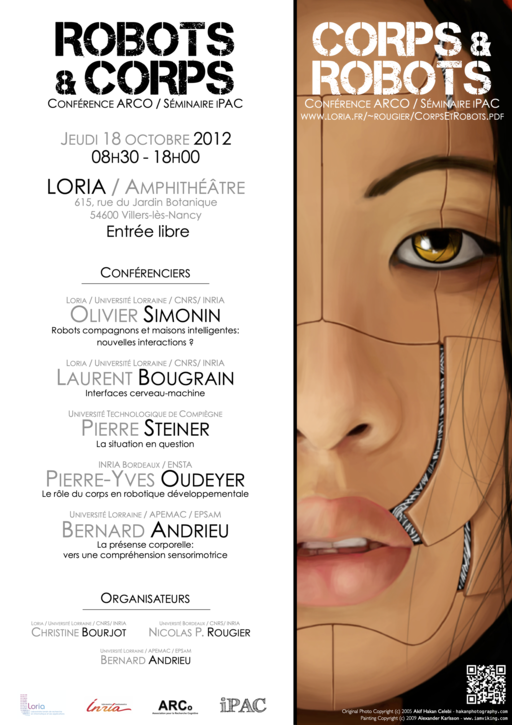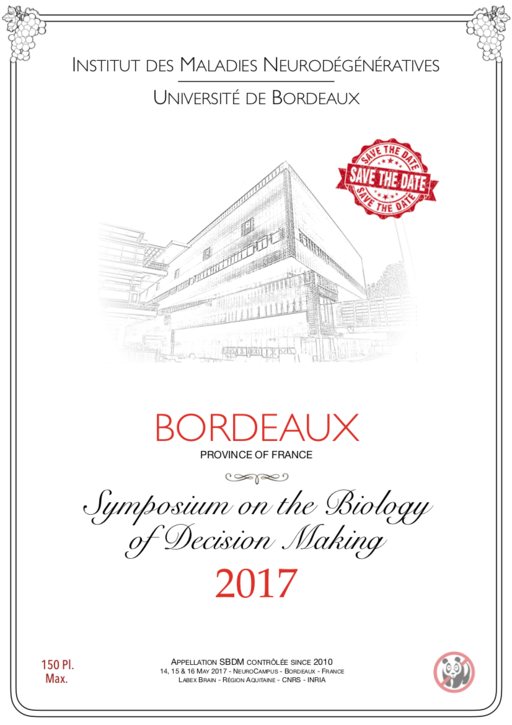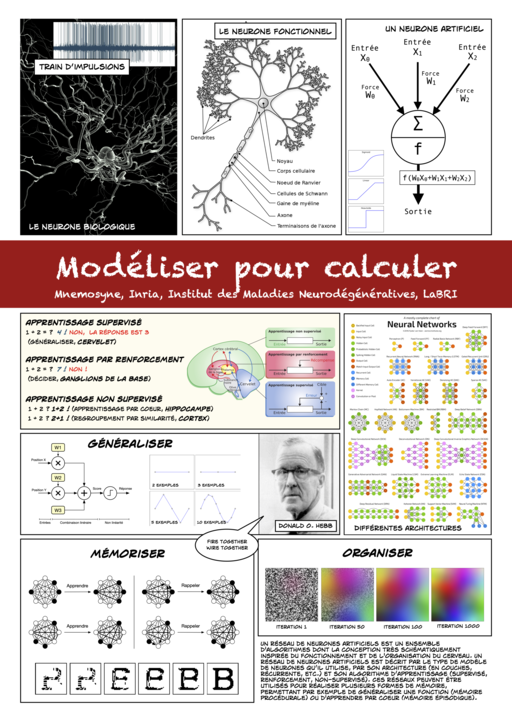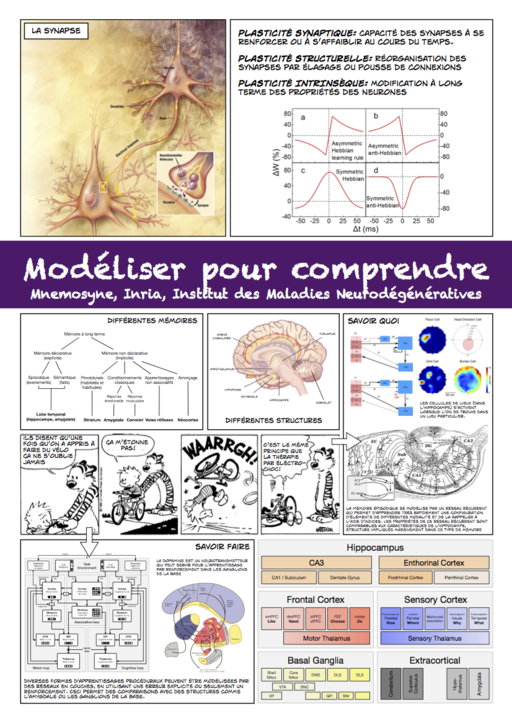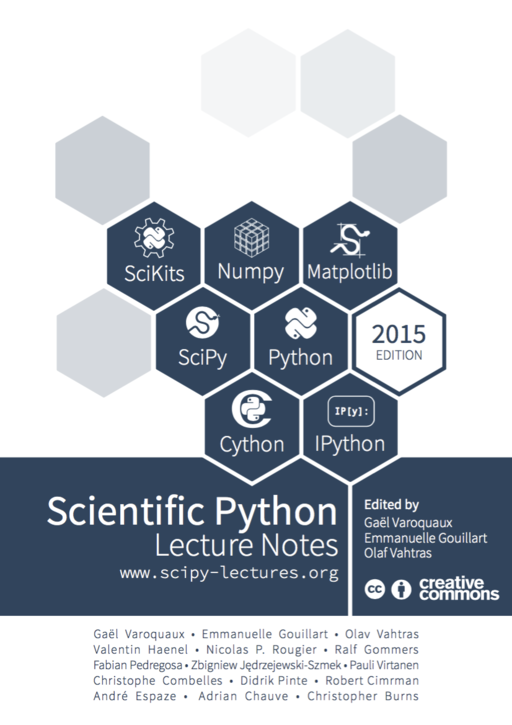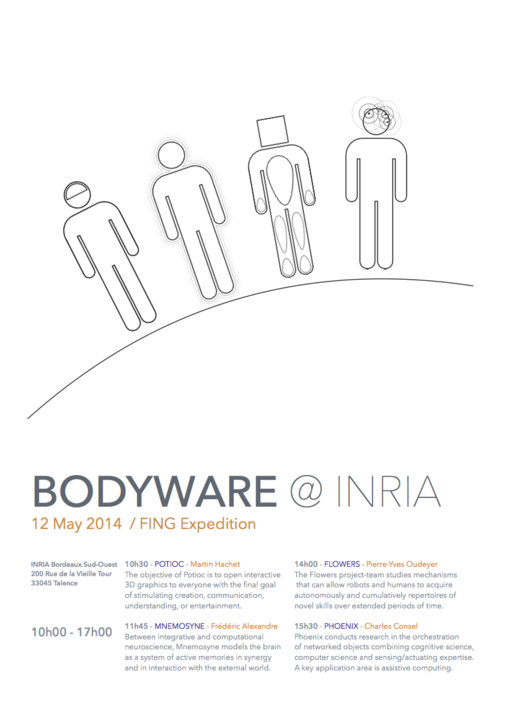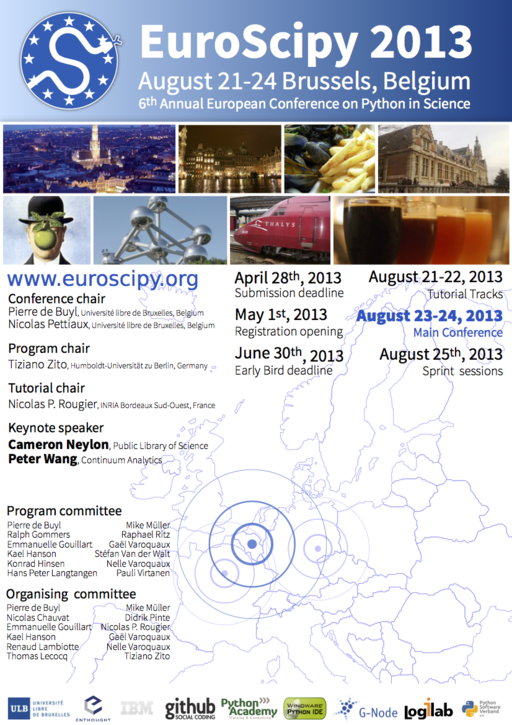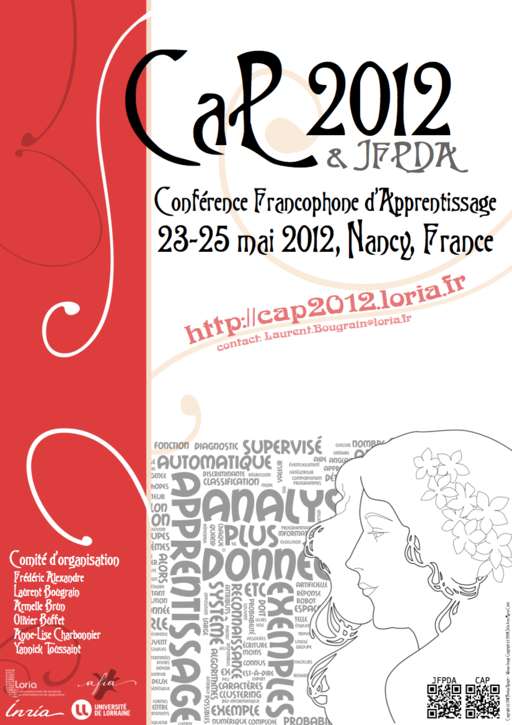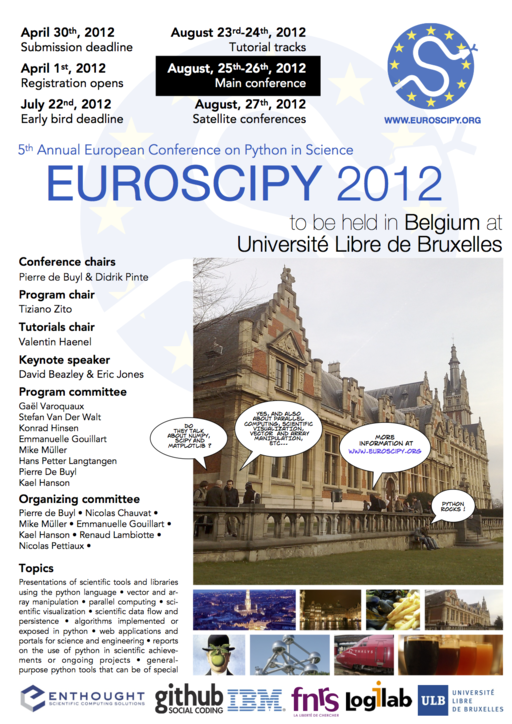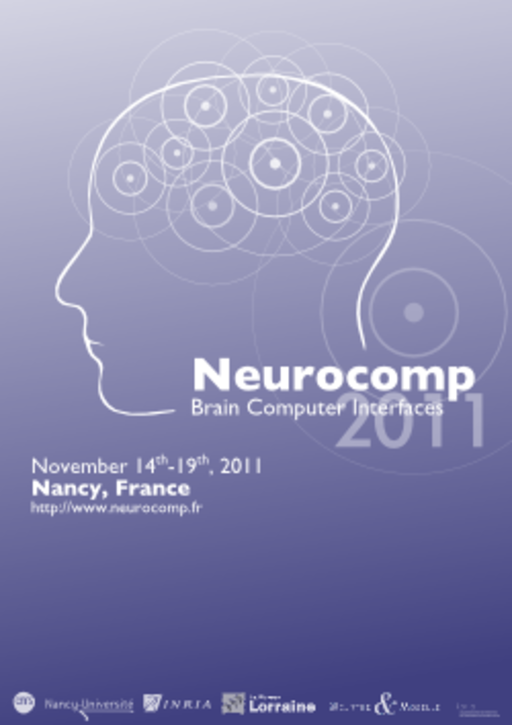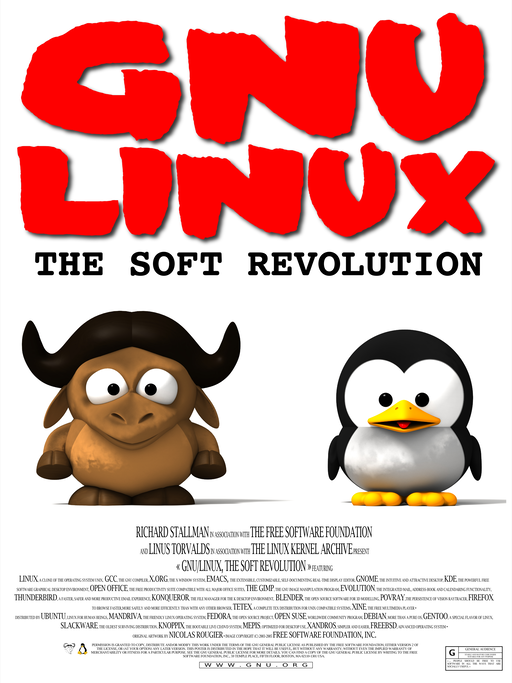NICOLAS.ROUGIER@INRIA.FR | RÉSUMÉ | GITHUB | BOOK | ORCID | NEWS
I’m a senior researcher (DR) in computational cognitive neuroscience at Inria and the Institute of Neurodegenerative Diseases (Bordeaux, France). I’m investigating decision making, learning and cognition using computational models of the brain and distributed, numerical and adaptive computing, a.k.a. artificial neural networks and machine learning. My research aims to irrigate the fields of philosophy with regard to the mind-body problem, medicine to account for the normal and pathological functioning of the brain and the digital sciences to offer alternative computing paradigms.
Direct access to bibliography (Calls, Highlights, Preprints, Books, Correspondences, Journals, Chapters, Conferences, Science outreach, Invited conferences, Invited lectures) and list of co-authors.
Contact
| Main office | Alternative office |
| Institut des Maladies Neurodégénératives | Inria Bordeaux Sud-Ouest |
| Centre Broca Nouvelle-Aquitaine | 200 Avenue de la Vieille Tour |
| 146 rue Léo Saignat - CS 61292 - Case 28 | 33405 Talence |
| 33076 Bordeaux cedex | Tel: +33 533 514 802 |
Professional history
| 2021 - … | Director of Research at (Inria) |
| Vice-head of the Hypermondes association | |
| 2020 - … | Head of the Computational Neuroscience team (IMN) |
| Vice‐head of the Mnemosyne team‐project (Inria BSO) | |
| Member of the DART team (LaBRI) | |
| 2013 - 2020 | Researcher (tenured) at Inria Bordeaux Sud‐Ouest |
| Vice‐head of the Mnemosyne team‐project | |
| Member of the Institute of Neurodegenerative Diseases | |
| Member of the LaBRI laboratory | |
| 2002 - 2013 | Researcher (tenured) at Inria Nancy Grand‐Est |
| Member of the Cortex team‐project | |
| Member of the Loria laboratory | |
| 2000 - 2002 | Associate Researcher at the Colorado University, Boulder, USA |
| Member of the O’Reilly Cognitive Psychology laboratory | |
Education
| 2011 | Habilitation, Université Nancy 2 |
| Fondements biologiques pour le calcul distribué, numérique et adaptatif | |
| 1997-2000 | Ph.D. in Computer Science, Université Henri Poincaré |
| Modèles de mémoires pour la navigation autonome | |
| (1996-1997 | Military service in naval aviation) |
| 1993-1996 | Engineer Telecom Nancy (ex ESIAL) |
| DEA (Master) in Computer Science , Université Nancy 1 |
Activities
Team leader of the computational neuroscience team at the institute of neurodegenerative diseases. Co‐founder and editor in chief of ReScience C and Rescience X, editor for PeerJ Computer Science, review editor for Frontiers in Neurobotics, Frontiers in Neuroscience, Frontiers in Psychology, member of the COSO Logiciel (Software and Source Codes College), member of the COFIS (Ofis Advisory Board), member of the FRRN (French National Reproducibility Network).
Former elected member of the national Inria evaluation committee, vice‐head of the Mnemosyne project, member of the Open Access Scholarly Publishers Association. I have directed 15 Phd Students, 4 post‐docs, ≈30 master students, reviewed and examined ≈40 PhD thesis and participated in more than 20 hiring committees (tenured position). I’m regularly teaching cognitive science, computational neuroscience, numerical computation and scientific visualization at university, doctoral schools and summer schools. I’ve also published several resources about scientific computation, scientific visualization and machine learning.
PhD students
Yousra Ouazzani Touhami 2025-2028
Mélanie Romano 2025-2028
Maeva Andriantsoamberomanga 2022-2025
Naomi Chaix-Echel (PhD) 2021-2024
Nikolaos Vardalakis (PhD) 2020-2024
Fjola Hyseni (PhD,MD) 2020-2023
Snighda Dagar (PhD) 2019-2023
Remya Sankar (PhD) 2018-2022
Anthony Strock (PhD) 2017-2020
Ikram Chraibi Kaadoud (PhD) 2015-1018
Aurélien Nioche (PhD) 2014-2018
Meropi Topalidou (PhD) 2013-2016
Georgios Detorakis (PhD) 2010-2013
Wahiba Taouali (PhD) 2009-2012
Jérémy Fix (PhD) 2005-2008
Julien Vitay (PhD) 2002-2006
Post-doc and engineers
Roshni Borse 2024-2025
Fabien Benureau 2016-1017
Zhor Ramdane-Cherif 2005-2006
Rémi Coulom 2003-2004
Alistair Bray 1998-2000
Interns
Yves Apriou (2025,Bordeaux) Héloise Troublé (2024, ENS Rennes) Pierre Schmittbuhl (2024, ENS Lyon) Gautham Venugopal (2023, IIIT Hyderabad, India) Victor Leroy (2022, ENST, Bordeaux) Rebecca Lafont (2022, Bordeaux INP) Bhushan Rugbursing (2021, Médecine/Science, Bordeaux), Karen Sobriel (2021, Université de Nantes), Quentin Lanneau (2021, ENSEIRB, Bordeaux), Kepa Labescau (2020, Médecine/Science, Bordeaux), Dimitri Lerévérend (2020, ENS Rennes), Nicolas Thou (2020, ENSEIRB, Bordeaux), Adrien Tétar (2019, ESIEE, Paris), Gabriel Gouraud (2019, Polytechnique, Saclay), Théophile Boraud (2018, Univ. Warwick, UK), Edwige Cyffers (2018, ENS, Lyon), Basile Garcia (2018, Univ. Bordeaux, Bordeaux), Remya Sankar (2017, IIIT Hyderabad, India), Anthony Strock (2017, ENS, Rennes), Sabyasachi Shivkumar (2016, IIIT Madras, India), Barghav teja Nallapu (2015, IIIT Hyderabad, Indoa), Aurélien Marie (2015, Univ. Bordeaux, Bordeaux), Hima Mehta (2014, IIIT Hyderabad, Inde), Meropi Topalidou (2013, Univ. Crete, Greece), Zoé Barbanneau (2011, Ecole Estienne, Paris), Wahiba Taouali (2009, Ecole des Mines, Nancy), Andrew Szabados (2008, Univ. Jussieu, Paris), Johnatan Gall (2006, Supélec, Metz), Jérémy Fix (2003, Supélec, Metz), Yoann Dieu (2003, Univ. Strasbourg, Strasbourg), Julien Vitay (2002, Supélec, Rennes).
Ongoing projects
Observatoire de la surveillance en démocratie (2024-…) At the crossroads of various scientific disciplines, such as law, computer science, information and communication sciences, sociology, history, economics, and political science, the OSD aims to promote multidisciplinary research and expertise on surveillance phenomena in democracy. In particular, the OSD aims to take stock of the techniques used by private and public actors whose goal—or effect—is to monitor part or all of the population.
French Network for Reproducible research (2021-…) The French Reproducible Research Network is a national initiative bringing together scientists engaged in the study of factors promoting reproducibility in research. Although the challenges of reproducibility vary across disciplines, they concern all scientific fields. The network therefore strives to represent a rich and balanced disciplinary diversity. The network has approximately 350 members registered, holding a variety of positions and come from numerous institutions throughout France. At least 30 different disciplines are represented. This diversity is a fundamental element of the network, which aims to promote the exchange of best practices and stimulate discussion around common procedures in different disciplines.
Psyphine (2010-…) This multidisciplinary group (computer science, philosophy, psychology, neuroscience, linguistic, ethnology) studies cognition from a theoretical and experimental perspective. We’ve designed a robotic lamp and study how people interact with it and interpret its behavior.
Hypermondes (2020-…) Hypermondes is an interprofessional, intergenerational collective of around thirty people who organize not only the Hypermondes Festival in September, but also events throughout the year focusing on science fiction, science, and the imagination for the general public, young people, book and education professionals, and corporate seminars. The Hypermondes Festival—completely free and open to all—is the flagship of an association whose strength lies in our shared passion for the imagination, our collective reflections, and our pleasure in sharing them with you!
Software
Glumpy is is a python library for scientific visualization that is both fast, scalable and beautiful. Glumpy offers an intuitive interface between numpy and modern OpenGL.
Freetype-GL is a C library for displaying text in OpenGL using one vertex buffer, one texture and the Freetype librart with flawless rendering quality in orthographic mode.
Machine learning recipes is a collection of stand-alone examples of machine learning algorithms in Python covering multi-armed bandits, artificial neural networks and Markod decision Processes.
DANA is a Python library for distributed asynchronous numerical and adaptive computing. The computational paradigm supporting the dana framework is grounded on the notion of a unit that is a set of arbitrary values that can vary along time under the influence of other units and learning.
→ See my GitHub page for more software and tutorials.
Artwork
Some artworks I designed for conferences and events I organized or co-organized over the years.
Bibliography
I appear (in general) as the first author when I have done the work prior to writing (design, modeling, implementation and/or analysis) and as the last author (or penultimate for some collaborations) when I have directly supervised or initiated the work (student, doctoral student, post-doctoral fellow). On the whole of my bibliography, I have about 300 co-authors and my scientific spectrum is mainly included in neurosciences and machine learning with however notable contributions in computer graphics, open and reproducible science and scientific visualization.
Major journals where I published are PNAS (2005), Neural Networks (2006, 2009) Neurocomputing (2011), PLoS Computational Biology (2014), Movement Disorders (2016), Progress in Neurobiology (2018), Neural Computation (2020), Science Advances (2020) Philosophical Transactions of the Royal Socitety B (2021) Nature (2025), but also Nature (2014, 2014, 2018, 2019, 2020) and Science (2019) for correspondences, interviews and reports on my work.
I’ve also given a course at SIGGRAPH which is the major conference in computer graphics and gave a talk ISHPSSB in 2019 which is the major conference in philosophy of biology.
Calls
- Inria, Software Heritage, and Unesco. 2019. Paris Call - Software Source Code as Heritage. https://en.unesco.org/foss/paris-call-software-source-code. Signatories: J-F. Abramatic, K. Albert, G. Alberts, K. Bradley, R. Buckley, N. Chue Hong, D. Clipsham, E. Cochrane, R. Di Cosmo, L. Duplouy, M. Gharsallah, J.M Greenberg, B. Guerry, M. Hinchey, P. Inverardi, V. Issarny, P. Madhavan, F. Marzano, G. Miura, P. Moreau, E. Nardelli, P. O’Donohue, M.R. Osuna Alarcón, J. Palm, T. Perelmuter, S. Phipps, C. Piana, N.P. Rougier, M. Sassi, D. Schüller, A. Seles, L. Shustek, A. Smith, M. Webb, P. Wheatley, S. Wyber URL
Highlights
- Thompson, B. and Howe, N. 2020. The challenge of reproducing results from ten-year-old code. Nature 584, 7822. Podcast on the "Ten Years Reproducibility Challenge" URL
- Perkel, J.M. 2020. Challenge to scientists: does your ten-year-old code still run? Nature 584, 7822, 656–658. Extended report on the "Ten Years Reproducibility Challenge" DOI URL
- Hutson, M. 2018. Artificial intelligence faces a replication crisis. Science 359, 6377. Interview about the ReScience journal URL
- Woolston, C. 2014. How to dodge the pitfalls of bad illustrations. Nature. Highlight on "Ten Simple Rules for Better Figures" DOI
- Nature. 2014. How to draw perfect figures. Nature 513, 7519, 463–463. Social selection about "Ten Simple Rules for Better Figures" DOI
Preprints
- Chaix-Eichel, N., Dagar, S., Alexandre, F., Boraud, T., and Rougier, N.P. 2025. The systematic nature of splitter cells. . DOI URL
- Chaix-Eichel, N., Dagar, S., Lanneau, Q., Sobriel, K., Boraud, T., Alexandre, F., and Rougier, N.P. 2022. From implicit learning to explicit representations. arXiv. DOI URL
- Rougier, N.P., Brun, C., and Boraud, T. 2021. A Mathematical Bias. HAL. URL
- Rougier, N.P. 2020. On the design of text editors. arXiv. URL
- Shivkumar, S., Chakravarthy, V.S., and Rougier, N.P. 2017. Modeling the Role of Striatum in Stochastic Multi Context Tasks. BioRxiv. DOI URL
- Rougier, N.P. and Timmer, J. 2017. Ten Simple Rules for Scientific Fraud & Misconduct. HAL. URL PDF
Books
- Rougier, N.P. and Edgar, S. 2024. IA Logs. Hypermondes.
- Rougier, N.P. 2020. Scientific Visualization: Python & Matplotlib. GitHub. URL
- Psyphine, ed. 2020. Que prêtons-nous aux machines ? Approches interdisciplinaires des interactions homme-robot. Presses Universitaires Paris Nanterres.
- Desquilbet Loı̈c, Granger, S., Hejblum, B., Legrand, A., Pernot, P., and Rougier, N.P. 2019. Vers une Recherche Reproductible. . URL
- Rougier, N.P. 2018. Python & OpenGL for Scientific Visualization. Zenodo. URL CODE
- Rougier, N.P. 2016. From Python to Numpy. Zenodo. DOI URL PDF CODE
- Varoquaux, G., Gouillart, E., Vahtras, O., Haenel, V., Rougier, N.P., Gommers, R., Pedregosa, F., Jedrzejewski-Szmek, Z., Virtanen, P., Combelles, C., Pinte, D., Cimrman, R., Espaze, A., Chauve, A., and Burns, C. 2015. Scipy Lecture Notes. Zenodo. DOI PDF CODE
Correspondences
- Alexandre, F., Hinaut, X., Rougier, N.P., and Viéville, T. 2021. Higher Cognitive Functions in Bio-Inspired Artificial Intelligence. ERCIM News 125. URL
- Rossant, C. and Rougier, N.P. 2021. High-performance interactive scientific visualization with DatoViz via the Vulkan low-level GPU API . Computing in Science & Engineering (IEEE) 23, 4. DOI URL
- Girau, B., Miramond, B., Rougier, N.P., and Upegui, A. 2021. Self Organizing Machine Architecture. ERCIM News 125. URL
- Roesch, E.B. and Rougier, N.P. 2020. New journal for reproduction and replication results. Nature 581, 7806, 30–30. DOI URL
- Hinsen, K. and Rougier, N.P. 2019. Challenge to test reproducibility of old computer code. Nature 574, 7780. DOI URL
- Hinsen, K. and Rougier, N.P. 2019. ReScience (R)evolution. ReScience 5. URL
- Rougier, N.P. and Hinsen, K. 2018. Code reviewing puts extra demands on referees. Nature 556, 7701. DOI
- Guest, O. and Rougier, N.P. 2017. Diversity in reproducibility. IEEE CDS Newsletter 13, 2. URL PDF CODE
- Guest, O. and Rougier, N.P. 2016. What is computational reproducibility? IEEE CDS Newsletter 13, 1. URL PDF CODE
- Topalidou, M., Leblois, A., Boraud, T., and Rougier, N.P. 2015. A Long Journey into Reproducible Computational Neuroscience. Frontiers in Computational Neuroscience 9, 28. DOI PDF
- Rougier, N.P. and Alexandre, F. 2003. Emergence of Representations Through Interactions of a Robot with the Real World. ERCIM News 53. URL PDF
Journals
- Di Cosmo, R., Granger, S., Hinsen, K., Jullien, N., Le Berre, D., Louvet, V., Maumet, C., Maurice, C., Monat, R., and Rougier, N.P. 2025. Stop treating code like an afterthought: record, share and value it. Nature 646, 8084. DOI
- Vardalakis, N., Aussel, A., Rougier, N.P., and Wagner, F.B. 2024. A dynamical computational model of theta generation in hippocampal circuits to study theta-gamma oscillations during neurostimulation. eLife. DOI URL
- Chraibi-Kaadoud, I., Rougier, N.P., and Alexandre, F. 2022. Knowledge extraction from the learning of sequences in a long short term memory (LSTM) architecture. Knowledge-Based Systems 235, 107657. DOI URL
- Sankar, R., Rougier, N.P., and Leblois, A. 2022. Computational benefits of structural plasticity, illustrated in songbirds. Neuroscience & Biobehavioral Reviews 132, 1183–1196. DOI URL
- Sankar, R., Thou, N., Rougier, N.P., and Leblois, A. 2021. [Re] A Reservoir Computing Model of Reward-Modulated Motor Learning and Automaticity. ReScience C 7, 1, #11. DOI URL
- Rougier, N.P. and Detorakis, G.I. 2021. Randomized Self Organizing Map. Neural Computation 33, 8, 2241–2273. DOI URL
- Nioche, A., Rougier, N.P., Deffains, M., Bourgeois-Gironde, S., Ballesta, S., and Boraud, T. 2021. The adaptive value of probability distortion and risk-seeking in macaques’ decision-making. Philosophical Transactions of the Royal Society B 376, 1819. DOI URL
- Strock, A., Rougier, N.P., and Hinaut, X. 2020. Latent space exploration and functionalization of a gated working memory model using conceptors. Cognitive Computation 15, 5, 1485–1496. DOI
- Detorakis, G., Chaillet, A., and Rougier, N.P. 2020. Stability analysis of a neural field self-organizing map. Journal of Mathematical Neuroscience 10, 1. DOI
- Strock, A., Hinaut, X., and Rougier, N.P. 2020. A Robust Model of Gated Working Memory. Neural computation 32, 1. URL PDF
- Bourdenx, M., Nioche, A., Dovero, S., Arotcarena, M.-L., Camus, S., Porras, G., Thiolat, M.-L., Rougier, N.P., Prigent, A., Aubert, P., Bohic, S., Sandt, C., Laferriere, F., Doudnikoff, E., Kruse, N., Mollenhauer, B., Novello, S., Morari, M., Leste-Lasserre, T., Damas, I.T., Goillandeau, M., Perier, C., Estrada, C., Carrillo, N.G., Recasens, A., Vaikath, N.N., El-Agnaf, O.M.A., Ezquerro, M.T.H., Derkinderen, P., Bover, M.V., Obeso, J.A., Dehay, B., and Bezard, E. 2020. Identification of distinct pathological signatures induced by patient-derived α-synuclein structures in non-human primates. Science Advances 6, 20, eaaz9165. DOI URL
- Nioche, A., Garcia, B., Lefebvre, G., Boraud, T., Rougier, N.P., and Bourgeois-Gironde, S. 2019. Coordination over a unique medium of exchange under information scarcity. Humanities and social sciences communications (Nature) 5, 1. DOI PDF CODE
- Nioche, A., Garcia, B., Boraud, T., Rougier, N.P., and Bourgeois-Gironde, S. 2019. Interaction effects between consumer information and firms’ decision rules in a duopoly: how cognitive features can impact market dynamics. Humanities and social sciences communications (Nature) 5. DOI URL
- Alliez, P., Guedj, B., Cosmo, R.D., Girault, A., Hacid, M.-S., Legrand, A., and Rougier, N.P. 2019. Attributing and Referencing (Research) Software: Best Practices and Outlook from Inria. Computing in Science & Engineering (IEEE). URL
- Topalidou, M., Kase, D., Boraud, T., and Rougier, N.P. 2018. A Computational Model of Dual Competition between the Basal Ganglia and the Cortex. eNeuro 5, 6. DOI
- Boraud, T., Leblois, A., and Rougier, N.P. 2018. A Natural History of Skills. Progress in Neurobiology 171. DOI
- Rougier, N.P. 2018. A Density-Driven Method for the Placement of Biological Cells Over Two-Dimensional Manifolds. Frontiers in Neuroinformatics 12. DOI CODE
- Benureau, F.C.Y. and Rougier, N.P. 2018. Re-run, Repeat, Reproduce, Reuse, Replicate: Transforming Code into Scientific Contributions. Frontiers in Neuroinformatics 11. DOI URL CODE
- Rougier, N.P., Hinsen, K., Alexandre, F., Arildsen, T., Barba, L., Benureau, F.C.Y., Brown, C.T., Buyl, P. de, Caglayan, O., Davison, A.P., Delsuc, M.A., Detorakis, G., Diem, A.K., Drix, D., Enel, P., Girard Benoı̂t, Guest, O., Hall, M.G., Henriques, R.N., Hinaut, X., Jaron, K.S., Khamassi, M., Klein, A., Manninen, T., Marchesi, P., McGlinn, D., Metzner, C., Petchey, O.L., Plesser, H.E., Poisot, T., Ram, K., Ram, Y., Roesch, E., Rossant, C., Rostami, V., Shifman, A., Stachelek, J., Stimberg, M., Stollmeier, F., Vaggi, F., Viejo, G., Vitay, J., Vostinar, A., Yurchak, R., and Zito, T. 2017. Sustainable computational science: the ReScience initiative. PeerJ Computer Science 3, e142. DOI CODE
- Rougier, N.P. 2017. [Re] Weighted Voronoi Stippling. ReScience 3, 1. DOI PDF CODE
- Piron, C., Kase, D., Topalidou, M., Goillandeau, M., Rougier, N.P., and Boraud, T. 2016. The globus pallidus pars interna in goal-oriented and routine behaviors: Resolving a long-standing paradox. Movement Disorders. DOI CODE
- Topalidou, M. and Rougier, N.P. 2015. [Re] Interaction between cognitive and motor cortico-basal ganglia loops during decision making: a computational study. ReScience 1, 1. DOI PDF CODE
- Taouali, W., Goffart, L., Alexandre, F., and Rougier, N.P. 2015. A parsimonious computational model of visual target position encoding in the superior colliculus. Biological Cybernetics 109, 4-5. DOI PDF CODE
- Rougier, N.P. 2014. Antialiased 2D Grid, Marker, and Arrow Shaders. Journal of Computer Graphics Techniques (JCGT) 3, 4, 1–52. URL PDF
- Rougier, N.P., Droettboom, M., and Bourne, P.E. 2014. Ten Simple Rules for Better Figures. PLoS Computational Biology 10, 9. DOI PDF CODE
- Detorakis, G. and Rougier, N.P. 2014. Structure of Receptive Fields in a Computational Model of Area 3b of Primary Sensory Cortex. Frontiers in Computational Neuroscience. DOI PDF
- Rougier, N.P. 2013. Shader-based Antialiased Dashed Stroke Poylines. Journal of Computer Graphics Techniques (JCGT) 2, 2, 105–121. URL PDF
- Rougier, N.P. 2013. Higher Quality 2D Text Rendering. Journal of Computer Graphics Techniques (JCGT) 2, 1, 50–64. URL PDF
- Rougier, N.P. and Fix, J. 2012. DANA: Distributed numerical and adaptive modelling framework. Network: Computation in Neural Systems 23, 4, 237–253. URL PDF CODE
- Detorakis, G.I. and Rougier, N.P. 2012. A Neural Field Model of the Somatosensory Cortex: Formation, Maintenance and Reorganization of Ordered Topographic Maps. PLoS ONE 7, 7, e40257. DOI PDF
- Taouali, W., Viéville, T., Rougier, N.P., and Alexandre, F. 2011. No Clock to Rule Them All. Journal Of Neurophysiology, Paris 105, 1–3. DOI PDF
- Rougier, N.P. and Boniface, Y. 2011. Dynamic Self-Organising map. Neurocomputing 74, 11, 1840–1847. DOI PDF CODE
- Rougier, N.P. and Hutt, A. 2011. Synchronous and Asynchronous Evaluation of Dynamic Neural Fields. Journal of Difference Equations and Applications 17, 8. DOI PDF
- Fix, J., Rougier, N.P., and Alexandre, F. 2011. A Dynamic Neural Field Approach to the Covert and Overt Deployment of Spatial Attention. Cognitive Computation 3, 1, 279–293. DOI PDF
- Hutt, A. and Rougier, N.P. 2010. Activity spread and breathers induced by finite transmission speeds in two-dimensional neural fields. Physical Review E 82, 5. DOI PDF CODE
- Rougier, N.P. 2009. Implicit and Explicit Representations. Neural Networks 22, 2, 155–160. DOI PDF
- Fix, J., Rougier, N.P., and Alexandre, F. 2007. From physiological principles to computational models of the cortex. Journal of Physiology, Paris, 32–39. DOI PDF
- Rougier, N.P. and Vitay, J. 2006. Emergence of Attention within a Neural Population. Neural Networks 19, 5, 573–581. DOI PDF
- Rougier, N.P. 2006. Dynamic Neural Field with Local Inhibition. Biological Cybernetics 94, 3, 169–179. DOI PDF
- Rougier, N.P., Noelle, D.C., Braver, T.D., Cohen, J.D., and O’Reilly, R.C. 2005. Prefrontal Cortex and Flexible Cognitive Control: Rules Without Symbols. Proceedings of the National Academy of Science 102, 20, 7338–7343. URL PDF
- Rougier, N.P. and O’Reilly, R.C. 2002. A Gated Prefrontal Cortex Model of Dynamic Task Switching. Cognitive Science 26, 4, 503–520. URL PDF
Chapters
- Rougier, N.P. and Hinsen, K. 2019. ReScience C: A Journal for Reproducible Replications in Computational Science. In: B. Kerautret, M. Colom, D. Lopresti, P. Monasse and H. Talbot, eds., Reproducible Research in Pattern Recognition. Springer, Cham. PDF
- Strock, A., Rougier, N.P., and Hinaut, X. 2019. Using Conceptors to Transfer Between Long-Term and Short-Term Memory. In: Artificial Neural Networks and Machine Learning. Springer International Publishing, 19–23. DOI URL
- Alexandre, F., Dominey, P.F., Gaussier, P., Girard Benoı̂t, Khamassi, M., and Rougier, N.P. 2019. When Artificial Intelligence and Computational Neuroscience meet. In: A guided tour of artificial intelligence research, Vol. 3 Interfaces and applications of artificial intelligence. Springer-Verlag.
- Chraibi-Kaadoud, I., Rougier, N.P., and Alexandre, F. 2017. Implicit Knowledge Extraction and Structuration from Electrical Diagrams. In: Advances in Artificial Intelligence: From Theory to Practice. Springer International Publishing, 235–241. DOI PDF
- Hutt, A. and Rougier, N.P. 2014. Numerical simulation scheme of one-and two-dimensional neural fields involving space-dependent delays. In: P. beim Graben, S. Coombes, R. Potthast and J.J. Wright, eds., Neural Field Theory. Springer. DOI PDF CODE
- Rougier, N.P. and Detorakis, G.I. 2013. Self-Organizing Dynamic Neural Fields. In: Y. Yamaguchi, ed., Advances in Cognitive Neurodynamics (III). Springer. DOI PDF CODE
- Taouali, W., Rougier, N.P., and Alexandre, F. 2012. Visual Target Selection Emerges from a Bio-inspired Network Topology. In: K. Kurosh Madani, A.D. Correia, A. Rosa and J. Filipe, eds., Computational Intelligence. Springer-Verlag. DOI PDF
- Fix, J., Vitay, J., and Rougier, N.P. 2007. A Computational Model of Spatial Memory Anticipation during Visual Search. In: M.V. Butz, O. Sigaud, G. Pezzulo and G. Baldassarre, eds., Anticipatory Behavior in Adaptive Learning Systems: From Brains to Individual and Social Behavior. Springer-Verlag Berlin Heidelberg. DOI PDF
- Vitay, J., Rougier, N.P., and Alexandre, F. 2005. A distributed model of visual spatial attention. In: S. Wermter, G. Palm and M. Elshaw, eds., Biomimetic Neural Learning for Intelligent Robotics. Springer-Verlag. DOI PDF
- Frezza-Buet, H., Rougier, N.P., and Alexandre, F. 2000. A cerebral framework for the integration of biologically inspired temporal mechanisms for sequence processing. In: L. Giles and R. Sun, eds., Neural, symbolic and Reinforcement methods for sequence learning. Springer. PDF
- Rougier, N.P. 1999. Mémoires déclarative et procédurale pour la navigation autonome d’un animat. In: A. Drogoul and J.A. Meyer, eds., Intelligence artificielle située. Cerveau, corps et environnement. Hermès. PDF
Conferences
- Rougier, N.P. 2025. L’IA à marche forcée. Technofascisme.
- Rougier, N.P. 2024. Les corps oubliés. Cerveau-machine : modèles et fictions, HyperHumains.
- Chaix-Eichel, N., Venugopal, G., Boraud, T., and Rougier, N.P. 2024. Exploring the role of structure in a time constrained decision task. 2024 IEEE International Conference on Development and Learning (ICDL), IEEE. URL
- Hyseni, F., Rougier, N.P., and Leblois, A. 2023. Modeling the Temporal Dynamics of the Songbird’s Premotor Nucleus. CNS.
- Leblois, A., Hyseni, F., and Rougier, N.P. 2023. Attractor dynamics drive flexible timing in birdsong. ICANN.
- Leroy, V., Guilhemsang, L., Rougier, N.P., and Mallet, N. 2023. Automatic quantification of normal & pathological behavior in mice. IBAGS XIV.
- Dagar, S.D., Alexandre, F., and Rouger, N.P. 2023. Computational models to explore constituents of Cognitive Control. Symposium on the Biology of Decision Making.
- Rougier, N.P. and Rossant, C. 2023. The Graphic Server Protocol (GSP). EuroScipy.
- Chaix-Eichel, N., Rougier, N.P., Boraud, T., and Ballesta, S. 2023. The influence of social rank on the attitude towards risk in non-human primates. Symposium on the Biology of Decision Making.
- Sankar, R., Leblois, A., and Rougier, N.P. 2022. Dual pathway architecture underlying vocal learning in songbirds. 2022 IEEE International Conference on Development and Learning (ICDL), IEEE. DOI URL
- Trouvain, N., Rougier, N.P., and Hinaut, X. 2022. Create Efficient and Complex Reservoir Computing Architectures with ReservoirPy. FROM ANIMALS TO ANIMATS 16: The 16th International Conference on the Simulation of Adaptive Behavior (SAB2022). URL PDF
- Dagar, S., Alexandre, F., and Rougier, N. 2022. From concrete to abstract rules : A computational sketch. The 15th International Conference on Brain Informatics. URL PDF
- Sankar, R., Rougier, N., and Leblois, A. 2022. Dual pathway architecture in songbirds boosts sensorimotor learning. Cosyne.
- Hyseni, F., Leblois, A., and Rougier, N. 2022. Temporal Dynamics in an Attractor Model of the Songbird’s Premotor Nucleus. Cosyne.
- Benureau, F.C.Y. and Rougier, N.P. 2019. Re-run, Repeat, Reproduce, Reuse, Replicate: Transforming Code into Scientific Contributions. SciPy Japan.
- Rougier, N.P. 2019. The Eye of the Modeler. International Society for the History Philosophy and Social Studies of Biology biennial meeting.
- Rougier, N.P. and Hinsen, K. 2018. ReScience C: a journal for reproducible replications in computational science. International Conference on Pattern Recognition (ICPR), Springer. PDF
- Upegui, A., Girau, B., Rougier, N.P., Vannel, F., and Miramond, B. 2018. Pruning Self-Organizing Maps for Cellular Hardware Architectures. NASA/ESA Conference on Adaptive Hardware and Systems.
- Rougier, N.P. and Esfahbod, B. 2018. Digital Typography Rendering. ACM SIGGRAPH. PDF
- Khacef, L., Girau, B., Rougier, N.P., Upegui, A., and Miramond Benoı̂t. 2018. Neuromorphic hardware as a self-organizing computing system. Neuromorphic Hardware In Practice and Use (NHPU) workshop 2018 in IEEE World Congress on Computational Intelligence (WCCI): International Joint Conference on Neural Networks (IJCNN). PDF
- Strock, A., Rougier, N.P., and Hinaut, X. 2018. A Simple Reservoir Model of Working Memory with Real Values. International Joint Conference on Neural Networks (IJCNN). PDF
- Strock, A., Rougier, N.P., and Hinaut, X. 2018. A Simple Reservoir Model of Working Memory with Real Values. Third workshop on advanced methods in theoretical neuroscience.
- Benureau, F., Boraud, T., and Rougier, N.P. 2017. Habits That Contradict Rewards. 7th Joint IEEE International Conference on Development and Learning and on Epigenetic Robotics, PDF
- Rougier, N.P. and Boniface, Y. 2017. Motivated Self-Organization. 12th International Workshop on Self-Organizing Maps and Learning Vector Quantization (WSOM). PDF
- Nallapu, B.T., Surampudi, B.R., and Rougier, N.P. 2017. The art of scaling up : a computational account on action selection in the basal ganglia. International Joint Conference in Neural Networks (IJCNN).
- Nallapu, B.T., Rougier, N.P., and Surampudi, B.R. 2016. The art of scaling up : a computational account on action selection in basal ganglia. Conference of the Association for Cognitive Science, India. PDF
- Nallapu, B.T. and Rougier, N.P. 2016. Dynamics of reward based decision making a computational study. International Conference on Artificial Neural Networks (ICANN). PDF
- Topalidou, M., Piron, C., Kase, D., Boraud, T., and Rougier, N.P. 2015. The Formation of habits. SBDM, Paris.
- Topalidou, M., Piron, C., Kase, D., Boraud, T., and Rougier, N.P. 2015. The Formation of Habits: implicit supervision of the basal ganglia. RLDM, Canada.
- Topalidou, M., Kase, D., Boraud, T., and Rougier, N.P. 2015. The Formation of habits. CNS, Prague.
- Rougier, N.P. 2015. Glumpy. Euroscipy. CODE
- Nallapu, B.T., Surampudi, B.R., and Rougier, N.P. 2015. Factors affecting reward based decision making : a computational study. International Conference on Cognition, Brain and Computation.
- Hinsen, K. and Rougier, N.P. 2015. The ReScience initiative. Euroscipy.
- Campagnola, L., Klein, A., Rossant, C., and Rougier, N.P. 2015. VisPy: Harnessing The GPU For Fast, High-Level Visualization. Scipy, USA. CODE
- Rougier, N.P. 2014. Modern Scientific Visualization. X Developer’s Conference.
- Campagnola, L., Klein, A., Rossant, C., and Rougier, N.P. 2013. Vispy: A Modern and Interactive Visualization Framework. Euroscipy. CODE
- Detorakis, G.I. and Rougier, N.P. 2012. Skin Topographic Maps in SI. Progress in Neural Field Theory.
- Rougier, N.P. and Detorakis, G.I. 2011. Self-Organizing Dynamic Neural Fields. Third International Conference on Cognitive Neurodynamics.
- Rougier, N.P. and Fix, J. 2011. Distributed, Numerical, Asynchronous and Adaptive computing framework. Python in Neuroscience, EurosScipy satellite.
- Rougier, N.P. 2010. From Computational Neurosience to Cellular Automata. Automata.
- Taouali, W., Rougier, N.P., and Frédéric, A. 2010. Saccades generation : from the visual input to the superior colliculus. International Conference on Neural Computation ICNC.
- Taouali, W., Frédéric, A., Hutt, A., and Rougier, N.P. 2009. Asynchronous Evaluation as an Efficient and Natural Way to Compute Neural Networks. 7th International Conference of Numerical Analysis and Applied Mathematics - ICNAAM.
- Fix, J., Rougier, N.P., and Alexandre, F. 2007. A top-down attentional system scanning multiple targets with saccades. From Computational Cognitive Neuroscience to Computer Vision.
- Ramdane-Cherif, Z.H. and Rougier, N.P. 2006. Etude des phénomènes d’occlusion dans l’attention visuelle spatiale. 1ère conférence francophone NEUROsciences COMPutationnelles - NeuroComp. PDF
- Fix, J., Vitay, J., and Rougier, N.P. 2006. A Computational Model of Spatial Memory Anticipation during Visual Search. Anticipatory Behavior in Adaptive Learning Systems.
- Alexandre, F., Rougier, N.P., and Viéville, T. 2006. A regularization process to implement self-organizing neuronal networks. International Conference on Engineering and Mathematics.
- Vitay, J. and Rougier, N.P. 2005. Using Neural Dynamics to Switch Attention. International Joint Conference on Neural Networtks (IJCNN).
- Vitay, J., Rougier, N.P., and Alexandre, F. 2004. Reducing connectivity by using cortical modular bands. European Symposium on Artificial Neural Networks (ESANN).
- Rougier, N.P. and Alexandre, F. 2001. A cerebral framework for integrating biologically plausible mechanisms in large connectionist models. International Conference on Systems in Biology.
- Rougier, N.P. 2001. Hippocampal Auto-Associative Memory. International Joint Conference on Neural Networtks (IJCNN).
- Rougier, N.P. and Alexandre, F. 2000. A Model of Hippocampal-Cortical Interaction Using a Synaptic Triad Mechanism. The Nature of Hippocampal-Cortical Interaction: Theoretical and Experimental Perspectives.
- Rougier, N.P., Frezza-Buet, H., and Alexandre, F. 1999. Neuronal mechanisms for sequence learning in behavioral modeling. Neural, Symbolic, and Reinforcement Methods for Sequence Learning Workshop, International Joint Conference on Artificial Intelligence (IJCAI).
- Rougier, N.P. and Alexandre, F. 1999. Spatial Knowledge Transfer Between Models of Hippocampus and Associative Cortex. International Joint Conference on Neural Networtks (IJCNN).
Science outreach
- Rougier, N.P. 2025. Sur l’intelligence artificielle générale (entretien). Le Parisien.
- Rougier, N.P. and Pucheu, D. 2025. Les dessous de l’Intelligence Artificielle. Village des Sciences.
- Rougier, N.P. and Pucheu, D. 2025. Intelligence Artificielle Générale: Mythe et limites. Village des Sciences.
- Rougier, N.P. 2024. IA : et si on arrêtait de raconter n’importe quoi ? Cap Sciences. URL
- Rougier, N.P. 2024. Transférer son esprit dans l’ordinateur (entretien). Usbek & Rica.
- Rougier, N.P. 2024. Il faut se méfier des discours colportés par les géants de l’IA (entretien). Charlie Hebdo.
- Carré, F., Queyssi, L., Vas-Deyres, N., Ly, O., and Rougier, N.P. 2023. Citizen Dialog: Les robots de la SF savent-ils marcher? . URL
- Carré, F., Queyssi, L., Vas-Deyres, N., Roussel, N., and Rougier, N.P. 2022. Mais pourquoi l’IA est-elle aussi méchante ? . URL
- Coris, M., Vas-Deyres, N., and Rougier, N.P. 2020. Intelligence artificielle : entre science et fiction . The Conversation (FR). URL
- Rougier, N.P. 2019. Why your cat is lousy at chess yet way smarter than even the most advanced AI . The Conversation (US). URL
- Rougier, N.P. 2019. Pourquoi votre chat est nul aux échecs et pourtant plus intelligent qu’une IA . The Conversation (FR). URL
- Rougier, N.P. 2019. Et le cerveau dans tout ça ? U magazine. URL
- Rougier, N.P. 2016. Silicon soul: The vain dream of electronic immortality. The Conversation (US). URL
- Rougier, N.P. 2016. Why you’ll never be able to upload your brain to the cloud. The Conversation (US). URL
- Rougier, N.P. 2015. L’intelligence artificielle, mythes et réalités. Interstices. URL
- Rougier, N.P. 2015. Une brève histoire de l’intelligence artificielle. http://pintofscience.fr. Pint of Science, Bordeaux, France URL
- Rougier, N.P. 2015. 3615 EULA. Binaires. URL
- Rougier, N.P. 2015. Pourquoi l’idée de télécharger son cerveau n’a pas de sens. The Conversation (FR). URL
- Rougier, N.P. 2015. Esprit in silico : les vains espoirs de l’immortalité. The Conversation (FR). URL
- Rougier, N.P. 2015. Faut-il avoir peur de l’intelligence artificielle ? Thinkovery #3. URL
- Rougier, N.P. 2015. L’intelligence artificielle n’aura pas lieu. Scilogs. URL
- Rougier, N.P. 2013. Outils et bibliothèques de visualisation. High Performance Computing.
- Rousseau, A., Darnaud, A., Goglin, B., Acharian, C., Leininger, C., Godin, C., Holik, C., Kirchner, C., Rives, D., Darquie, E., Kerrien, E., Neyret, F., Masseglia, F., Dufour, F., Berry, G., Dowek, G., Robak, H., Xypas, H., Illina, I., Gnaedig, I., Jongwane, J., Ehrel, J., Viennot, L., Guion, L., Calderan, L., Kovacic, L., Collin, M., Enard, M.-A., Comte, M.-H., Quinson, M., Olivi, M., Giraud, M., Dorémus, M., Ogouchi, M., Droin, M., Lacaux, N., Rougier, N.P., Roussel, N., Guitton, P., Peterlongo, P., Cornus, R.-M., Vandermeersch, S., Maheo, S., Lefebvre, S., Boldo, S., Viéville, T., Poirel, V., Chabreuil, A., Fischer, A., Farge, C., Vadel, C., Astic, I., Dumont, J.-P., Féjoz, L., Rambert, P., Paradinas, P., De Quatrebarbes, S., and Laurent, S. 2013. Médiation Scientifique : une facette de nos métiers de la recherche. . URL PDF
- Rougier, N.P. 2013. Percer les mystères du cerveau. Interstices. URL
- Rougier, N.P. 2013. Petite histoire de la cybercriminalité. Journée pédagogique pour l’ISN. URL
- Rougier, N.P. 2011. Mémoire vive. Universcité #4. URL
Invited conferences
- Rougier, N.P. 2025. Une brève histoire de l’Intelligence Artificielle. Chambre Régionale des Comptes.
- Rougier, N.P. 2025. Ouvrir les codes et logiciels : enjeux et bonnes pratiques pour la recherche. Open Science Week.
- Rougier, N.P. 2024. Une histoire naturelle de la décision. Rhodia, Laboratoire du Futur .
- Rougier, N.P. 2024. On computational reproducibility. DKM Days (Rennes). URL
- Rougier, N.P. 2023. L’expérience sensible du monde. TEDx Quartier Latin (Paris). URL
- Rougier, N.P. 2023. On the Design of Scientific Visualization. Colloquium of the Institute of Mathematics, Potsdam University.
- Rougier, N.P. 2023. Reproducible Science. 1st Open Science Workshop (Bordeaux).
- Rougier, N.P. 2023. Open Science. 1st Open Science Workshop (Bordeaux).
- Rougier, N.P. 2023. Digital Typography. Huawei Technical Summit (Oslo).
- Rougier, N.P. 2022. Reproducible Research, one bit a a time. Inria Rennes (CP).
- Rougier, N.P. 2022. Modern data visualization. Janelia Research Campus.
- Rougier, N.P. 2022. Data visualization. Open Planetary Lunch.
- Rougier, N.P. 2021. The Art of Braincrafting. European Neuroscience Conference by Doctoral Students (ENCODS). URL
- Rougier, N.P. 2021. Long-term reproducibility. Société Informatique de France. URL
- Rougier, N.P. 2021. Méthodes numériques et formation. 8ème journées du réseau des URFIST. URL
- Rougier, N.P. 2019. Bootstrapping Cognition. Robotics, development and neurosciences. URL
- Rougier, N.P. 2018. ReScience. Enabling Reproducibility in Machine Learning MLTrain@RML (ICML 2018). URL
- Rougier, N.P. 2018. We ReDo Science. Bernstein PhD Symposium. URL
- Rougier, N.P. 2017. Reproducible Science. University of Reading (UK). URL
- Rougier, N.P. 2017. Decision Making: who’s in charge? Lex Robotica. URL
- Rougier, N.P. 2017. Scientific publishing on GitHub. Emerging models in scientific communication (CNS 2017). URL
- Rougier, N.P. 2017. ReScience, one year after. Openscience, transparence et évaluation. URL
- Rougier, N.P. 2017. Noise and Decision. Symposium on the Biology of Decision Making. URL
- Rougier, N.P. 2016. ReScience. Loi Numérique, et après ? URL
- Rougier, N.P. 2016. Two actors, one critic. Robotique & Neurosciences. URL
- Rougier, N.P. 2016. Open Science. AdaWeek. URL
- Rougier, N.P. 2015. Distributed, Asynchronous, Numerical & Adaptive computing. BioComp. URL
- Rougier, N.P. 2015. From Neuron to Behavior. Neuropsychology through the lenses of computational modelling.
- Rougier, N.P. 2015. ReScience, refaire la science. Retour d’expériences sur la recherche reproductible. URL
- Rougier, N.P. 2015. On ne voit que ce que l’on regarde. Unithé ou Café.
- Rougier, N.P. 2014. Cortical Plasticity. Bernstein Conference workshop. URL
- Rougier, N.P. 2014. Cortical plasticity, a computational approach. International Conference on Neural Field Theory. URL
- Rougier, N.P. 2014. Cortical plasticity. Computational Neuroscience Network. URL
- Rougier, N.P. 2014. Where is my mind? Forum des Sciences Cognitives. URL
- Rougier, N.P. 2013. We see only what we look at. Cerveau et Informatique.
- Rougier, N.P. 2013. Where is my mind? La Robotique et le Vivant. URL
- Rougier, N.P. 2012. Dynamic Neural Fields. Brain & Signals.
- Rougier, N.P. 2011. Models of Visual Attention. Intelligence Artificielle Embarquée.
- Rougier, N.P. 2009. Architecture Cérébrale et Robotique Autonome. Robots, Hybrides et Corps. URL
- Rougier, N.P. 2008. Visual Attention. Computational Vision.
- Rougier, N.P. 2007. Some questions around consciousness. Conceptual Neuroscience (European Institute Para Limes). URL
- Rougier, N.P. 2007. Visual Attention. Models of Language Evolution, Acquisition and Processing.
- Rougier, N.P. 2006. Computational Neurocience for Humanoïd robotics. Japanese-French Frontiers of Science. URL
- Rougier, N.P. 2003. Rules without symbols. Computational Models of Active Maintenance in Prefrontal Cortex.
- Rougier, N.P. 2000. Mémoire Déclarative. Xèmes Journées Neurosciences et Sciences de l’Ingénieur.
Invited Lectures
- Rougier, N.P. 2024. IA génératives: promesses et limites. MOOC AI4T. URL
- Rougier, N.P. 2023. How to explain your job to your grandma? 1st Open Science Workshop (Bordeaux). URL
- Rougier, N.P. 2023. How to write better code? 1st Open Science Workshop (Bordeaux). URL
- Rougier, N.P. 2023. Data Visualization. European College of Sport Science (ECSS).
- Rougier, N.P. 2023. French Reproducibility Network. SOFT days.
- Rougier, N.P. 2023. Open Science. Hacking Cognition.
- Rougier, N.P. 2023. Scientific Visualization. Service d’Expérimentation et de Développement (Nancy).
- Rougier, N.P. 2022. Reproducible Research, one bit a a time. Ecole Centrale Lille.
- Rougier, N.P. 2022. Ten Simple Rules for Better Figures. Café Python et Visualisation.
- Rougier, N.P. 2020. Data Visualization. AI for Industry.
- Rougier, N.P. 2019. The Dark Side of Science. Intégrité Scientifique.
- Rougier, N.P. 2017. Less is more. Python Scientifique.
- Rougier, N.P. 2016. An Introduction to Matplotlib. SciPy.
- Rougier, N.P. 2016. Modern scientific visualization. Advanced Scientific Programming in Python.
- Rougier, N.P. 2016. From Single Neuron to Population. Electromagnetic Fields and the Nervous System.
- Rougier, N.P. 2015. Advanced Neural Fields. Computational Neuroscience Symposium.
- Rougier, N.P. 2015. An Introduction to Matplotlib. EuroScipy.
- Rougier, N.P. 2014. Scientific visualization challenge. Prospectom.
- Rougier, N.P. 2014. Reinforcement Learning. Latin-America Summer School in Computational Neuroscience.
- Rougier, N.P. 2013. Scientific visualization. PRACE Winter School.
- Rougier, N.P. 2013. An introduction to Matplotlib. EuroScipy.
- Rougier, N.P. 2013. Visualisation Scientifique. Journées du dévelopement.
- Rougier, N.P. 2010. Embodied Cognition. National Institute of Informatics (Tokyo, Japan).
- Rougier, N.P. 2010. Visual Attention. National Institute of Informatics (Tokyo, Japan).
- Rougier, N.P. 2010. Introduction to Neural Fields. National Institute of Informatics (Tokyo, Japan).
- Rougier, N.P. 2010. Models of Visual Attention. National Institute of Informatics (Tokyo, Japan).
List of co-authors
J.-F. Abramatic, C. Acharian, M.O. Alarcòn, K. Albert, G. Alberts, F. Alexandre, P. Alliez, V. André, T. Arildsen, M. Arotcarena, I. Astic, P. Aubert, S. Ballesta, L. Barba, J. Becker, F.C.Y. Benureau, G. Berry, E. Bezard, I. Blanc, S. Bohic, S. Boldo, Y. Boniface, T. Boraud, A. Boumaza, M. Bourdenx, S. Bourgeois-Gironde, P.E. Bourne, M.V. Bover, K. Bradley, T.D. Braver, C.T. Brown, R. Buckley, C. Burns, P. de Buyl, O. Caglayan, L. Calderan, L. Campagnola, S. Camus, N.G. Carrillo, A. Chabreuil, A. Chaillet, N. Chaix-Echel, V.S. Chakravarthy, A. Chauve, I. Chraibi-Kaadoud, R. Cimrman, D. Clipsham, E. Cochrane, J.D. Cohen, M. Collin, C. Combelles, M. Comte, R. Cornus, S. Dagar, I.T. Damas, A. Darnaud, E. Darquie, A.P. Davison, M. Deffains, S. De Quatrebarbes, B. Dehay, M.A. Delsuc, P. Derkinderen, L. Desquilbet, G.I. Detorakis, R. Di Cosmo, A.K. Diem, P.F. Dominey, M. Dorémus, E. Doudnikoff, S. Dovero, G. Dowek, D. Drix, M. Droettboom, M. Droin, F. Dufour, J. Dumont, L. Duplouy, A. Dutech, J. Ehrel, O.M.A. El-Agnaf, M. Enard, P. Enel, B. Esfahbod, A. Espaze, C. Estrada, M.T.H. Ezquerro, C. Farge, A. Fischer, J. Fix, H. Frezza-Buet, L. Féjoz, B. Garcia, P. Gaussier, M. Gharsallah, V. Giardino, B. Girard, B. Girau, M. Giraud, A. Girault, I. Gnaedig, C. Godin, L. Goffart, B. Goglin, M. Goillandeau, R. Gommers, E. Gouillart, S. Granger, J. Greenberg, B. Guedj, B. Guerry, O. Guest, L. Guion, P. Guitton, M. Hacid, V. Haenel, M.G. Hall, B. Hejblum, R.N. Henriques, X. Hinaut, M. Hinchey, K. Hinsen, C. Holik, N.C. Hong, A. Hutt, F. Hyseni, I. Illina, P. Inverardi, V. Issarny, K.S. Jaron, Z. Jedrzejewski-Szmek, J. Jongwane, D. Kase, E. Kerrien, L. Khacef, M. Khamassi, C. Kirchner, A. Klein, L. Kovacic, N. Kruse, N. Lacaux, F. Laferriere, S. Laurent, D. Le Berre, A. Leblois, G. Lefebvre, S. Lefebvre, A. Legrand, C. Leininger, T. Leste-Lasserre, F. Louis, V. Louvet, P. Madhavan, S. Maheo, T. Manninen, P. Marchesi, F. Marzano, F. Masseglia, D. McGlinn, C. Metzner, B. Miramond, G. Miura, B. Mollenhauer, M. Morari, P. Moreau, B.T. Nallapu, E. Nardelli, F. Neyret, A. Nioche, D.C. Noelle, S. Novello, P. O’Donohue, R.C. O’Reilly, J.A. Obeso, M. Ogouchi, M. Olivi, J. Palm, P. Paradinas, F. Pedregosa, F. Pellegrini, T. Perelmuter, C. Perier, P. Pernot, O.L. Petchey, P. Peterlongo, S. Phipps, C. Piana, D. Pinte, C. Piron, H.E. Plesser, V. Poirel, T. Poisot, G. Porras, A. Prigent, M. Quinson, K. Ram, Y. Ram, P. Rambert, Z. Ramdane-Cherif, M. Rebuschi, A. Recasens, M. Renauld, D. Rives, H. Robak, E. Roesch, C. Rossant, V. Rostami, A. Rousseau, N. Roussel, C. Sandt, M. Sassi, D. Schüller, A. Seles, A. Shifman, S. Shivkumar, L. Shustek, A. Smith, J. Stachelek, M. Stimberg, F. Stollmeier, A. Strock, B.R. Surampudi, W. Taouali, M. Thiolat, J. Timmer, M. Topalidou, A. Upegui, C. Vadel, F. Vaggi, O. Vahtras, N.N. Vaikath, S. Vandermeersch, F. Vannel, N.Vardalakis, G. Varoquaux, F. Verhaegen, G. Viejo, L. Viennot, P. Virtanen, J. Vitay, T. Viéville, A. Vostinar, F.Wagner, M. Webb, P. Wheatley, S. Wyber, H. Xypas, R. Yurchak, T. Zito. </div>
Last updated on 20 December 2025 - Made with Jekyll and Jekyll-Scholar
